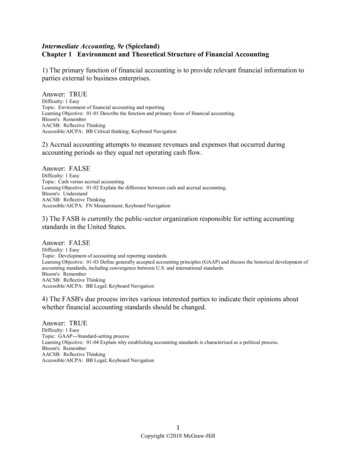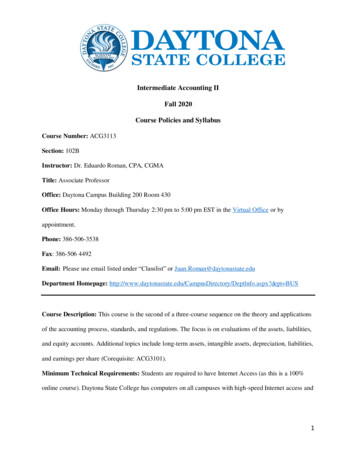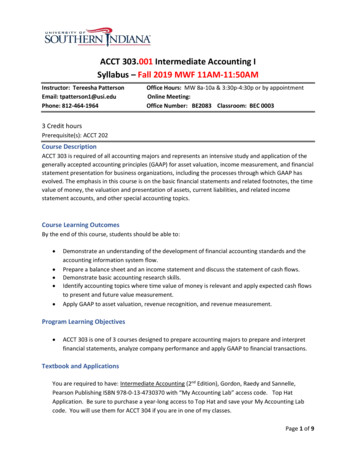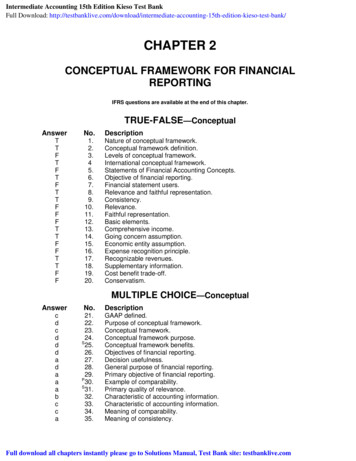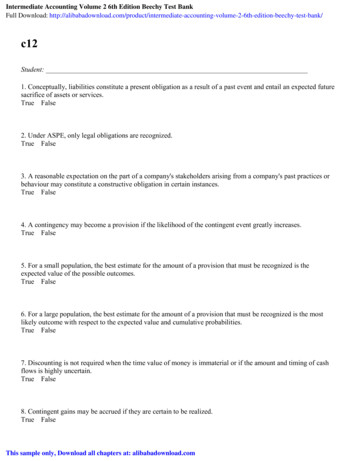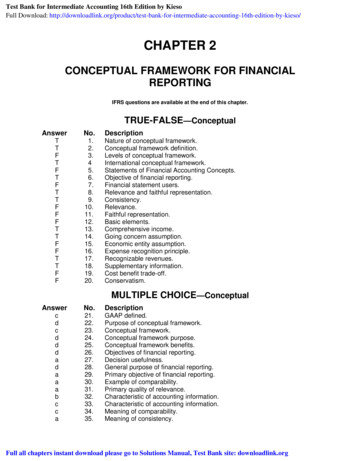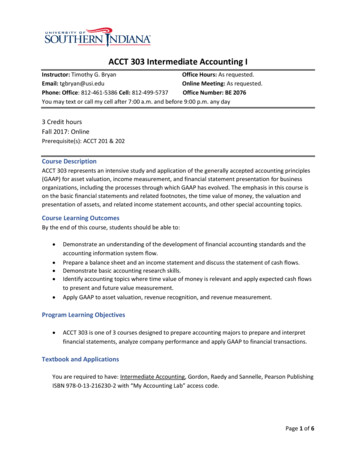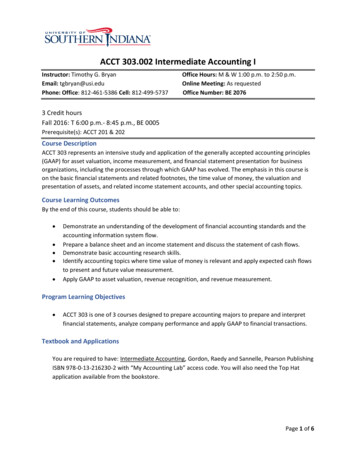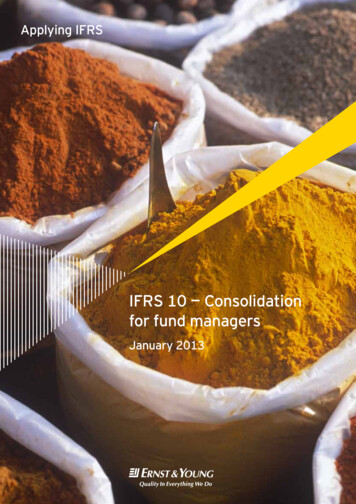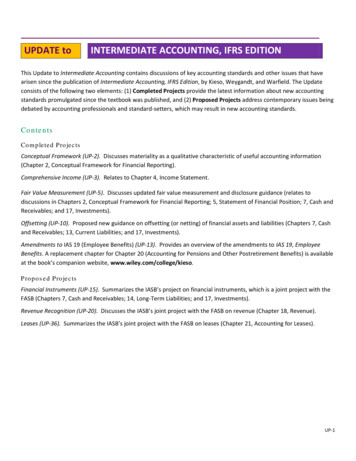
Transcription
UPDATE toINTERMEDIATE ACCOUNTING, IFRS EDITIONThis Update to Intermediate Accounting contains discussions of key accounting standards and other issues that havearisen since the publication of Intermediate Accounting, IFRS Edition, by Kieso, Weygandt, and Warfield. The Updateconsists of the following two elements: (1) Completed Projects provide the latest information about new accountingstandards promulgated since the textbook was published, and (2) Proposed Projects address contemporary issues beingdebated by accounting professionals and standard-setters, which may result in new accounting standards.Co n te n tsCo m p le te d P ro je c tsConceptual Framework (UP-2). Discusses materiality as a qualitative characteristic of useful accounting information(Chapter 2, Conceptual Framework for Financial Reporting).Comprehensive Income (UP-3). Relates to Chapter 4, Income Statement.Fair Value Measurement (UP-5). Discusses updated fair value measurement and disclosure guidance (relates todiscussions in Chapters 2, Conceptual Framework for Financial Reporting; 5, Statement of Financial Position; 7, Cash andReceivables; and 17, Investments).Offsetting (UP-10). Proposed new guidance on offsetting (or netting) of financial assets and liabilities (Chapters 7, Cashand Receivables; 13, Current Liabilities; and 17, Investments).Amendments to IAS 19 (Employee Benefits) (UP-13). Provides an overview of the amendments to IAS 19, EmployeeBenefits. A replacement chapter for Chapter 20 (Accounting for Pensions and Other Postretirement Benefits) is availableat the book’s companion website, www.wiley.com/college/kieso.P ro p o s e d P ro je c tsFinancial Instruments (UP-15). Summarizes the IASB’s project on financial instruments, which is a joint project with theFASB (Chapters 7, Cash and Receivables; 14, Long-Term Liabilities; and 17, Investments).Revenue Recognition (UP-20). Discusses the IASB’s joint project with the FASB on revenue (Chapter 18, Revenue).Leases (UP-36). Summarizes the IASB’s joint project with the FASB on leases (Chapter 21, Accounting for Leases).UP-1
UP-2 Update to Intermediate Accounting, IFRS EditionCOMP LETED P ROJ ECTSCONCEP TUAL FRAMEWORKThe discussion in this section provides background on revisions in the treatment of materiality as it relates to qualitativecharacteristics of useful accounting information in the conceptual framework. Replacement pages for affected materialin Chapter 2 follow the Background section and are also available at the book’s companion website, www.wiley.com/college/kieso.Ba c kg ro u n dIn September 2010, the IASB and FASB issued revised chapters in their conceptual frameworks, resulting in convergedconcepts statements related to the Objective of Financial Reporting (Chapter 1) and Qualitative Characteristics of UsefulFinancial Information (Chapter 3). However, the discussion of these topics in Chapter 2 of Intermediate Accounting, IFRSEdition, was based on the proposed (not final) chapters at the time the textbook was published in spring 2010. Oneelement that changed in the final versions of these chapters, compared to the proposed concepts statements,concerned materiality.In the proposed framework and consistent with the prior concepts statements, materiality was treated as aconstraint in the conceptual framework. However, based on input from constituents, in the final revised chapter,materiality is presented as an element of the relevance—one of the primary qualitative characteristics—along withfaithful representation.Revised pages that reflect the updated treatment of materiality follow. These pages can be substituted for thediscussion of qualitative characteristics on pages 43-47 in Chapter 2. The discussion of the materiality constraint onpages 57-59 may be dropped. Finally, a revised Illustration 2-7, which summarizes the “Framework for FinancialReporting,” is provided to replace page 60.
CHAPTER2 UPDATECONCEPTUAL FRAMEWORK FOR FINANCIAL REPORTINGThe following discussion reflects the most recent accounting standards concerning the conceptualframework. It should replace pages 43–47 and page 60, and the Materiality Constraint section onpages 57–59 may be dropped, in Chapter 2 of Intermediate Accounting, IFRS Edition.SECOND LEVEL: FUNDAMENTAL CONCEPTSThe objective (first level) focuses on the purpose of financial reporting. Later, we willdiscuss the ways in which this purpose is implemented (third level). What, then, is thepurpose of the second level? The second level provides conceptual building blocks thatexplain the qualitative characteristics of accounting information and define the elementsof financial statements.1 That is, the second level forms a bridge between the why ofaccounting (the objective) and the how of accounting (recognition, measurement, andfinancial statement presentation).Qualitative Characteristics of Accounting InformationShould companies like Marks and Spencer plc (GBR) or Samsung Electronics Ltd.Objective 4(KOR) provide information in their financial statements on how much it costs themIdentify the qualitative characteristo acquire their assets (historical cost basis) or how much the assets are currentlytics of accounting information.worth (fair value basis)? Should PepsiCo (USA) combine and show as one company the four main segments of its business, or should it report PepsiCo Beverages, Frito Lay, Quaker Foods, and PepsiCo International as four separate segments?How does a company choose an acceptable accounting method, the amount and typesof information to disclose, and the format in which to present it? The answer: By determining which alternative provides the most useful information for decision-makingpurposes (decision-usefulness). The IASB identified the qualitative characteristics ofaccounting information that distinguish better (more useful) information from inferior(less useful) information for decision-making purposes. In addition, the IASB identifieda cost constraint as part of the conceptual framework (discussed later in the chapter). AsIllustration 2-2 (on page 2U-2) shows, the characteristics may be viewed as a hierarchy.As indicated by Illustration 2-2, qualitative characteristics are either fundamentalor enhancing characteristics, depending on how they affect the decision-usefulness ofinformation. Regardless of classification, each qualitative characteristic contributes tothe decision-usefulness of financial reporting information. However, providing usefulfinancial information is limited by a pervasive constraint on financial reporting—costshould not exceed the benefits of a reporting practice.Fundamental Quality—RelevanceRelevance is one of the two fundamental qualities that make accounting informationuseful for decision-making. Relevance and related ingredients of this fundamentalquality are shown below.FundamentalqualityIngredients of rmatoryvalueMateriality1The Conceptual Framework for Financial Reporting, “Chapter 3, Qualitative Characteristics ofUseful Financial Information” (London, U.K.: IASB, September 2010).2U-1
2U-2·Chapter 2 UpdateILLUSTRATION 2-2Hierarchy of AccountingQualitiesConceptual Framework for Financial ReportingCAPITAL PROVIDERS (Investors and Creditors)AND THEIR CHARACTERISTICSPrimary users ofaccounting informationConstraintCOSTPervasive gredients UL To be relevant, accounting information must be capable of making a difference ina decision. Information with no bearing on a decision is irrelevant. Financial information is capable of making a difference when it has predictive value, confirmatory value,or both.Financial information has predictive value if it has value as an input to predictiveprocesses used by investors to form their own expectations about the future. For example, if potential investors are interested in purchasing ordinary shares in Nippon(JPN), they may analyze its current resources and claims to those resources, its dividend payments, and its past income performance to predict the amount, timing, anduncertainty of Nippon’s future cash flows.Relevant information also helps users confirm or correct prior expectations; it hasconfirmatory value. For example, when Nippon issues its year-end financial statements,it confirms or changes past (or present) expectations based on previous evaluations. Itfollows that predictive value and confirmatory value are interrelated. For example, information about the current level and structure of Nippon’s assets and liabilities helpsusers predict its ability to take advantage of opportunities and to react to adverse situations. The same information helps to confirm or correct users’ past predictions aboutthat ability.Materiality is a company-specific aspect of relevance. Information is material ifomitting it or misstating it could influence decisions that users make on the basis ofthe reported financial information. An individual company determines whether information is material because both the nature and/or magnitude of the item(s) to whichthe information relates must be considered in the context of an individual company’sfinancial report. Information is immaterial, and therefore irrelevant, if it would have noimpact on a decision-maker. In short, it must make a difference or a company neednot disclose it.Assessing materiality is one of the more challenging aspects of accounting becauseit requires evaluating both the relative size and importance of an item. However, it isdifficult to provide firm guidelines in judging when a given item is or is not material.Materiality varies both with relative amount and with relative importance. For example,the two sets of numbers in Illustration 2-3 indicate relative size.
Second Level: Fundamental ConceptsCompany ACompany BSalesCosts and expenses 10,000,0009,000,000 100,00090,000Income from operations 1,000,000 10,000Unusual gain 20,0005,000During the period in question, the revenues and expenses, and therefore the net incomes of Company A and Company B, are proportional. Each reported an unusualgain. In looking at the abbreviated income figures for Company A, it appears insignificant whether the amount of the unusual gain is set out separately or merged with theregular operating income. The gain is only 2 percent of the operating income. If merged,it would not seriously distort the income figure. Company B has had an unusual gainof only 5,000. However, it is relatively much more significant than the larger gainrealized by Company A. For Company B, an item of 5,000 amounts to 50 percent ofits income from operations. Obviously, the inclusion of such an item in operating incomewould affect the amount of that income materially. Thus, we see the importance of therelative size of an item in determining its materiality.Companies and their auditors generally adopt the rule of thumb that anythingunder 5 percent of net income is considered immaterial. However, much can dependon specific rules. For example, one market regulator indicates that a company may usethis percentage for an initial assessment of materiality, but it must also consider otherfactors.2 For example, companies can no longer fail to record items in order to meetconsensus analysts’ earnings numbers, preserve a positive earnings trend, convert aloss to a profit or vice versa, increase management compensation, or hide an illegaltransaction like a bribe. In other words, companies must consider both quantitativeand qualitative factors in determining whether an item is material.Thus, it is generally not feasible to specify uniform quantitative thresholds at whichan item becomes material. Rather, materiality judgments should be made in the contextof the nature and the amount of an item. Materiality factors into a great many internalaccounting decisions, too. Examples of such judgments that companies must makeinclude the amount of classification required in a subsidiary expense ledger, the degreeof accuracy required in allocating expenses among the departments of a company, andthe extent to which adjustments should be made for accrued and deferred items. Onlyby the exercise of good judgment and professional expertise can reasonable andappropriate answers be found, which is the materiality constraint sensibly applied.Fundamental Quality—Faithful RepresentationFaithful representation is the second fundamental quality that makes accounting information useful for decision-making. Faithful representation and related ingredients ofthis fundamental quality are shown below.FundamentalqualityIngredients of thefundamentalquality2FAITHFUL REPRESENTATIONCompletenessNeutralityFree from error“Materiality,” SEC Staff Accounting Bulletin No. 99 (Washington, D.C.: SEC, 1999). Theauditing profession also adopted this same concept of materiality. See “Audit Risk andMateriality in Conducting an Audit,” Statement on Auditing Standards No. 47 (New York:AICPA, 1983), par. 6.·2U-3ILLUSTRATION 2-3Materiality Comparison
2U-4·Chapter 2 UpdateConceptual Framework for Financial ReportingFaithful representation means that the numbers and descriptions match what really existed or happened. Faithful representation is a necessity because most users haveneither the time nor the expertise to evaluate the factual content of the information. Forexample, if Siemens AG’s (DEU) income statement reports sales of 60,510 millionwhen it had sales of 40,510 million, then the statement fails to faithfully represent theproper sales amount. To be a faithful representation, information must be complete,neutral, and free of material error.Completeness. Completeness means that all the information that is necessary for faithful representation is provided. An omission can cause information to be false or misleading and thus
Hierarchy of Accounting Qualities. Second Level: Fundamental Concepts· 2U-3 During the period in question, the revenues and expenses, and therefore the net in-comes of Company A and Company B, are proportional. Each reported an unusual gain. In looking at the abbreviated income figures for Company A, it appears insignif- icant whether the amount of the unusual gain is set out separately or .



